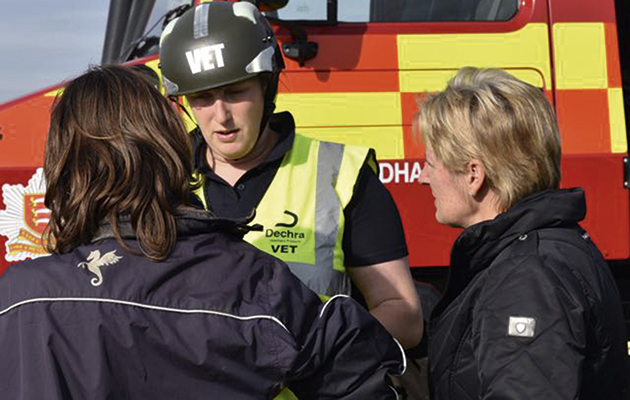Disaster does not discriminate. Any type of equine can end up in an emergency situation, from grazing ponies caught in floodwater to competition horses trapped in an overturned lorry or a burning building.
The UK’s fire and rescue services are called to an estimated 5,000 large animal rescues every year, according to Jim Green, animal rescue specialist. Many of these are equine-related. Yet, despite this statistic, few owners treat problem prevention as a priority — especially when it is hard to see an obvious return for the time and money spent.
The less common a potential catastrophe, the harder it is to find motivation to take precautions to reduce risk. But remember, arson attacks are on the increase and flooding has been all too frequent this winter.
The British Animal Rescue and Trauma Care Association (BARTA) held its first international conference in Prague (3-5 December) to discuss effective management of animal-related incidents, be it fire, flood, entrapment or other disaster.
Those at the conference agreed that large-animal rescues bring huge challenges. Thinking about it calmly, it is obvious that people must take priority in any rescue scenario. In an emergency situation, however, owners sometimes struggle to accept that humans come before horses.
Speakers at the conference pooled their expertise and discussed memorable rescues, both good and bad. Every catastrophe is different and opportunities for emergency services to gain hands-on experience are limited, hence the need to share knowledge.
Fire facts
Effective fire safety was a major focus. There were excellent, albeit alarming, presentations on equine evacuations after the recent devastating bush fires in Australia, plus much discussion on how best to manage horses in cases of fire.
An American review, presented by Rebecca Gimenez, highlighted the horrors of fires involving horses where more than 70% of the premises were ablaze by the time rescue services arrived. Of 1,200 animals involved in more than 104 fires, less than half could be rescued and 701 died. Among the human responders were 31 injuries and two fatalities.
The awful truth is that many rescued horses later succumb to the effects of burns, smoke inhalation and associated lung damage. Horses are likely to inhale the smoke and toxic gases that rise upwards in a fire, as they hold their heads high when they panic.
The severity of injury to the lungs can be more serious than visible burns affecting the skin — burning to the delicate lung tissue can cause severe respiratory problems. Clinical signs are often immediate, yet horses should remain under observation for at least 72 hours as some may not exhibit signs for two to three days.
Treatment includes use of supplementary oxygen, if practical, and sometimes a tracheostomy — where a breathing tube is inserted into the windpipe to create an open airway. Various medications can also help, but treatment is challenging and the long-term prognosis is unpredictable and variable. If there are also extensive skin burns, it may be time to think seriously about whether it is fair to continue.
Prevention is key
Dry straw burns faster than petrol. A fire involving combustible materials (such as wood, straw, hay and shavings) will double in size every minute — increasing by more than 4,000 times in just 10 minutes.
The emergency services can only do so much, especially in the case of rural or isolated yards that may take time to reach, so prevention is key. This means thinking about practical stable design and reducing flammable materials at the yard.
Allow clear access for emergency vehicles at all times, ensuring that stable doors are easy to open and left unlocked — imagine a firefighter trying to open them in full protective gear, including gloves.
And how will a horse already frightened by fire react to firefighters? He’ll most probably be reluctant to come anywhere near them, let alone be led out to safety.
One sensible suggestion is to accustom horses to fire alarms by running a regular practice before feeding, for example.
Plan ahead now so there is more than one escape route for the horses, ideally leading to a safe, fenced-off area that is upwind. Loose horses are an additional hazard and can soon become casualties on the road. Indeed, the fire and rescue services classify horses as “hazardous material” during an incident and will not release them unless there is a safe place for evacuation.
It’s equally important to ensure that everyone knows the location of water supplies for the fire brigade and that all safety information is clearly visible.
As Anton Phillips of the Hampshire Fire and Rescue Service summarised at the conference, rescuing animals from burning buildings is risky and often unachievable. Firefighters cannot be relied upon as the only measure to protect animals from fire, he pointed out, adding that owners who have planned for such an incident are less likely to lose everything than those who have not.
Ref: Horse & Hound; 25 February 2016

